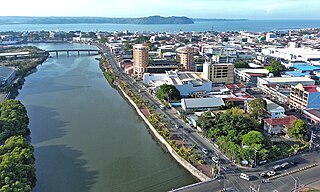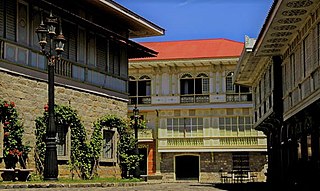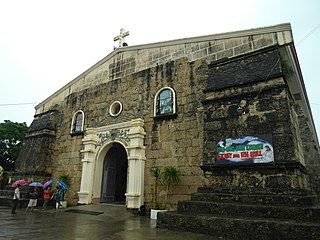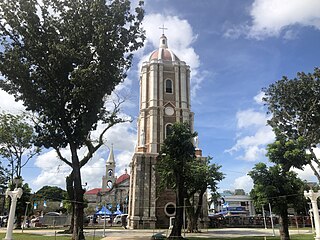
Iloilo, officially the Province of Iloilo, is a province in the Philippines located in the Western Visayas region. Its capital and largest city is Iloilo City, the regional center of Western Visayas. Iloilo occupies the southeast portion of the Visayan island of Panay and is bordered by the province of Antique to the west, Capiz to the north, the Jintotolo Channel to the northeast, the Guimaras Strait to the east, and the Iloilo Strait and Panay Gulf to the southwest.

Iloilo City, officially the City of Iloilo, is a 1st class highly urbanized city in the Western Visayas region of the Philippines, located on the southeastern coast of the island of Panay. It is the capital city of the province of Iloilo, where it is geographically situated and grouped under the Philippine Statistics Authority, but remains politically independent in terms of government and administration. In addition, it is the center of the Iloilo–Guimaras Metropolitan Area, as well as the regional center and primate city of the Western Visayas region. According to the 2020 census, Iloilo City has a population of 457,626 people. For the metropolitan area, the total population is 1,007,945 people.

Santa Barbara, officially the Municipality of Santa Barbara, is a 2nd class municipality in the province of Iloilo, Philippines. According to the 2020 census, it has a population of 67,630 people.

Jaro is a district in Iloilo City, Philippines, located on Panay Island in the Western Visayas region. It is the largest district in terms of both area and population, with 130,700 people according to the 2020 census. Jaro merged with Iloilo City in the 1940s during the American administration in the Philippines. It is also the largest among the seven districts of Iloilo City. La Paz district and the present municipalities of Leganes and Pavia were historically part of Jaro before becoming independent.
The legislative districts of Iloilo City are the representations of the highly urbanized city of Iloilo in the various national legislatures of the Philippines. The city is currently represented in the lower house of the Congress of the Philippines through its lone congressional district.

Molo is a district in Iloilo City, in Iloilo Province, on Panay Island in the Western Visayas region of the Philippines. It is the most densely populated district of all the seven districts of Iloilo City. It was originally a separate municipality before it became part of Iloilo through Act No. 719 of 1903. Molo's historical significance stems from its role as the Parián or Chinatown of Iloilo, where the Chinese residents of the city resided.

Iloilo City Proper is a district in Iloilo City, in the Western Visayas region of the Philippines. It holds great historical significance as the birthplace of modern-day Iloilo City and serves as a civic center, hosting the city and provincial government offices, as well as various local, provincial, and regional government establishments. The district also serves as the primary hub for financial institutions, with banks and other firms dispersed throughout its streets.

The architecture of the Philippines reflects the historical and cultural traditions in the country. Most prominent historic structures in the archipelago are influenced by Austronesian, American architectures.

The National Museum of the Philippines is an umbrella government organization that oversees a number of national museums in the Philippines including ethnographic, anthropological, archaeological, and visual arts collections. From 1973 until 2021, the National Museum served as the regulatory and enforcement agency of the government of the Philippines in the restoring and safeguarding of significant cultural properties, sites, and reservations throughout the Philippines. The mandate has since been transferred to the National Commission for Culture and the Arts.

The National Shrine of Our Lady of the Candles, also known as the Metropolitan Cathedral of Saint Elizabeth of Hungary and colloquially as Jaro Cathedral, is a cathedral located in the district of Jaro in Iloilo City, on the island of Panay in the Philippines. The seat of the Roman Catholic Archdiocese of Jaro, it was placed under the patronage of Saint Elizabeth of Hungary. It was established in 1575 as a visita (chapel-of-ease) of Oton by the Augustinians and as a separate parish in 1587. The present-day structure of Jaro Cathedral was built in 1874.

La Paz is a district in Iloilo City, in the Philippine province of Iloilo, on the island of Panay, in the region of Western Visayas. It is the third-largest district by land area, after Jaro and Mandurriao. According to the 2020 census, it has a population of 54,720 people. In the past, it was known as Ilawod, which means "sea/wet land," along with Jaro, which was referred to as Ilaya, meaning "mountain/dry land."

Ancestral houses of the Philippines or Heritage Houses are homes owned and preserved by the same family for several generations as part of the Filipino family culture. It corresponds to long tradition by Filipino people of giving reverence for ancestors and elders. Houses could be a simple house to a mansion. The most common ones are the "Bahay na Bato". Some houses of prominent families had become points of interest or museums in their community because of its cultural, architectural or historical significance. These houses that are deemed of significant importance to the Filipino culture are declared Heritage House by the National Historical Commission of the Philippines (NHCP), previously known as the National Historical Institute (NHI) of the Philippines. Preservation is of utmost importance as some ancestral houses have come into danger due to business people who buy old houses in the provinces, dismantle them then sell the parts as ancestral building materials for homeowners wishing to have the ancestral ambiance on their houses. These ancestral houses provide the current generation a look back of the country's colonial past through these old houses.

Passi, officially the City of Passi, is a 4th class component city in the province of Iloilo, Philippines. According to the 2020 census, it has a population of 88,873 people.

The San Joaquin Parish Church, commonly known as San Joaquin Church, is a Roman Catholic Church in the municipality of San Joaquin, Iloilo, Philippines within the jurisdiction of the Roman Catholic Archdiocese of Jaro. It is largely known for its pediment featuring a military scene, the Spanish victory over the Moors in the Battle of Tétouan. The church was declared a National Cultural Treasure by the National Museum of the Philippines.

The San Joaquin Campo Santo is a Roman Catholic cemetery situated in the town of San Joaquin in Iloilo, Philippines. It is a designated as a National Cultural Treasure by the National Museum of the Philippines together with San Joaquin Church.

The Federal State of the Visayas was a revolutionary state in the Philippine archipelago during the revolutionary period. It was a proposed administrative unit of a Philippines under a federal form of government.

The National Museum (NM) Western Visayas Regional Museum, simply known as the National Museum Western Visayas, is a museum in Iloilo City, Philippines.

Iloilo City is a conglomeration of former cities and towns in the Philippines, which are now the geographical or administrative districts (boroughs) composed of seven: Arevalo, City Proper, Jaro, La Paz, Lapuz, Mandurriao, and Molo. All administrative districts are divisions of the lone congressional district of Iloilo City, and each is composed of barangays (barrios), with a total of 180 city barangays.

Graciano Lopez Jaena Park, also known as Jaro Plaza or locally Plaza Jaro, is an urban park and town square located in the district of Jaro in Iloilo City, Panay Island, Philippines.





















